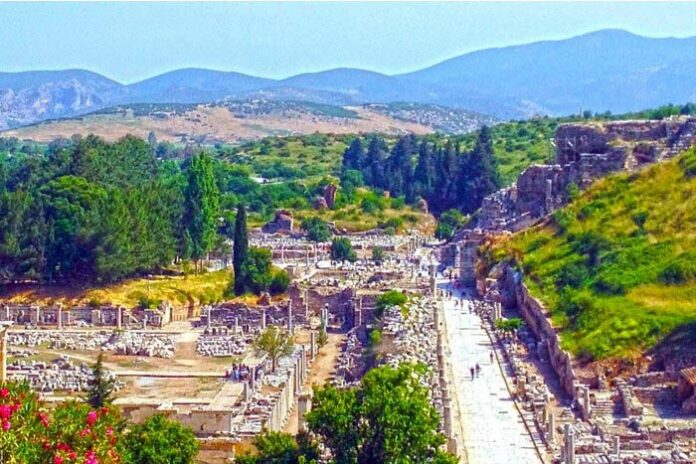Ephesus day tours – Ephesus
Ephesus day tours – Foundation of Ephesus antique city goes until 6000 B.C. Based on recent studies and excavations, bronze age and Hittite settlements were explored on the Ayasuluk Hill where a fortress is located and in tumuluses located around Ephesus (pre-historical hill settlement).
The city was referred as Apasas in the Hittite period. A port city Ephesus, where immigrants from Greece arrived and settled around 1050 B.C., moved to the areas around Artemis Temple in 560 B.C. Today’s Ephesus City was established by Lysimakhos (named Arsione his wife’s name), one of the commanders of Alexander the Great, around 300 B.C. As Ephesus experienced its most prosperous and magnificent times in Hellenistic and Roman periods, it was populated about 200,000 as a capital of Asia state and as the largest harbor city. Ephesus relocated once more in the Byzantium period and moved to the Ayasuluk Hill in Selcuk County where it was first established.
What is the most significant characteristic of Ephesus City?
As an important gate between east and west, Ephesus was primary harbor city. Such position enabled this city to become the most important political and commercial center of its era; and made it capital of the Asia state in Roman period. This was not the sole reason made Ephesus important in the antique age. The largest temple of the Artemis culture based on the mother-goddess Kybele tradition of Anatolia was located in Ephesus as well. Artemis Temple in Ephesus is considered as one of the Seven Wonders of the World.
Ephesus day tours – Ephesus was an antique Greek city; which then became a Roman, located on the western coast of Anatolia 3 km away from today’s Selcuk County. In the classical Greek period, it was one of the twelve cities of Ionia. Its foundation could be traced back until 6000 B.C. the Neolithic period. In the recent studies and excavations in the region; settlements from the Bronze Age and Hittite periods were determined around the tumuluses surrounding the Ephesus and on the Ayasuluk Hill where the fortress was located. The name of the city was Apasas in the Hittite period.
A port city Ephesus, where immigrants from Greece arrived and settled around 1050 B.C.; moved to the areas around Artemis Temple in 560 B.C. Lysimakhos, one of the commanders of Alexander the Great, established today’s Ephesus City around 300 B.C. As Ephesus experienced its most prosperous and magnificent times in Hellenistic and Roman periods; it was populated about 200,000 as a capital of Asia state and as the largest harbor city.
Ephesus day tours – Byzantium period
Ephesus relocated once more in the Byzantium period and moved to the Ayasuluk Hill in Selcuk County where it was first established. Ayasuluk conquered by Turks in 1330 and became capital of Aydinogullari State. Then, its population and significance faded afterwards of 16th Century continuously. Finally, by the time Turkish Republic announced in 1923, it was renamed as Selcuk; today it is a tourism town housing 30,000 population.








